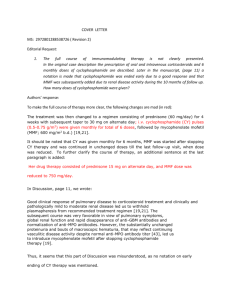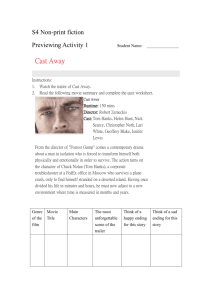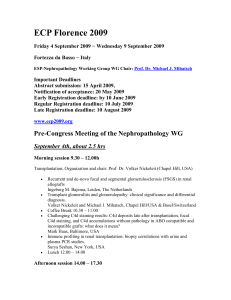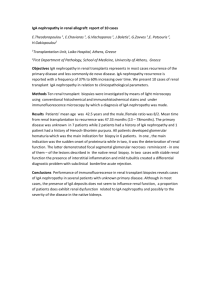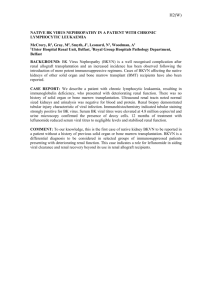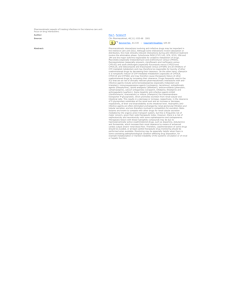Cast Nephropathy & Plasmapheresis
advertisement
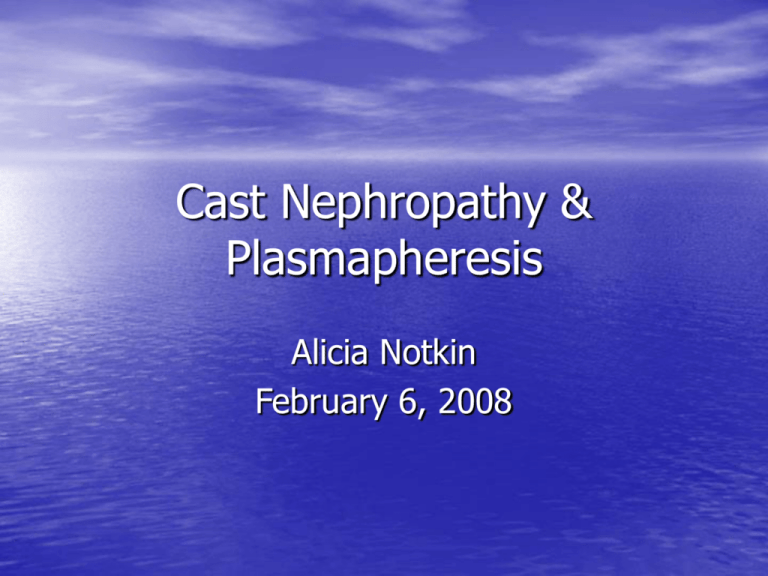
Cast Nephropathy & Plasmapheresis Alicia Notkin February 6, 2008 Pathogenesis of cast nephropathy • Renal failure from immunoglobulin or κ or λ light chains: direct tubular toxicity & obstruction • Light chains (MW 22000) are freely filtered across the glomerulus & then reabsorbed by proximal tubular epithelial cells Pathogenesis of cast nephropathy • Overproduction of light chains tubular capacity for reabsorption is exceeded • Filtered light chains & immunoglobulins then bind Tamm-Horsfall glycoprotein (secreted in the medullary TAL of the loop of Henle) • Cast formation & obstruction in the distal nephron subsequently results Pathogenesis of cast nephropathy (Sanders 1990) • Bence Jones proteins loop segment dysfunction • decreased NaCl absorption increased early distal tubule NaCl concentration which promotes aggregation/cast formation (shown in rats in vivo) Proteins w/ isoelectric points > 5.1 aggregate w/ THP in vitro (increasing NaCl or CaCl2 concentration enhances aggregation); in vivo, not all cationic proteins casts (partly b/c of differences in distal nephron NaCl concentration & b/c of variable affinity of the immunoglobulin light chains to the binding site on the THP) % change in turbidity (from co-precipitation) v. NaCl concentration for in vitro solutions of THP w/ various low molecular weight proteins (Sanders 1990) Pathogenesis of cast nephropathy: in vivo rat data (Sanders 1992) • Obstruction occurred in the distal nephron only • • • & showed direct BJP-concentration dependence Obstruction took significantly longer to develop in rats given volume infusion at high rates Obstruction developed more rapidly with increasing furosemide concentrations Colchicine prevented obstruction by decreasing tubular secretion & carbohydrate content of THP Change in turbidity of in vitro solutions of rat THP +/- colchicine w/ increasing concentrations of furosemide (Sanders 1992) Compounding factors… • • • • • • Hypercalcemia Hyperuricemia Infection Volume depletion or loop diuretics Nephrotoxic drugs, IV contrast Proximal tubular injury from light chain reabsorption & interference w/ lysosomal function; cycle whereby dysfunction further decrease in light chain reabsorption Treatment of cast nephropathy • Volume repletion: decrease tubular light chain • • • concentration, decrease tubular NaCl concentration Increase urine flow: decrease light chain precipitation Alkalinize urine: raise urine pH above isoelectric point to decrease affinity toward anionic TammHorsfall proteins (controversial) Chemotherapy to decrease immunoglobulin production Plasmapheresis to remove circulating free light chains? • Many studies are small, non-randomized, retrospective, are heterogeneous… • 3 prospective, randomized trials: 2 favor plasmapheresis, while most recent one casts doubt on its use Plasmapheresis? • Zucchelli 1988: 29 patients (24/83% req dialysis), 59% biopsied, Cr > 5mg/dl not responsive to hydration, 80% treated previously w/ cytotoxic drugs, all given methylprednisolone & cyclophosphamide & randomized to plasmapheresis w/ prn HD vs. prn PD; 13/15 v. 2/14 w/ renal improvement; also survival benefit Plasmapheresis? • Johnson 1990: 21 patients (57% req dialysis), 76% biopsied, all given melphalan, prednisone, & forced diuresis, 11 plasmapheresed, subgroup analysis of dialysis dependent patients – renal recovery in 47% pheresed v. 0% control Plasmapheresis? • Clark 2005: 97 patients (26 v. 36% initially on dialysis in plasmapheresis v. control group), few biopsied, treated w/ vincristine, adriamycin, dexamethasone or melphalan & prednisone, +/plasmapheresis, no statistically significant difference in composite endpoint of death, dialysis dependence, gfr < 30 ml/min @ 6 months Plasmapheresis? • Leung 2007: retrospective study in 40 patients, cast nephropathy in 18/28 patients (64.3%) that were biopsied, w/ these patients having renal response associated w/ >/= 50% reduction in sFLC levels (77.8% v. 0%, p = 0.001), & w/ sFLC reduction not affecting renal recovery in the other 10 patients, post-treatment sFLC level predicted renal response (p = 0.01) & renal response predicted long-term survival (p = 0.04) – median survival 31.8 v. 11 months References • Clark, WF et al. Plasma exchange when myeloma presents as acute renal failure: a • • • • • • randomized, controlled trial. Ann Intern Med 2005; 143:777. Huang, ZQ et al. Localization of a single binding site for immunoglobulin light chains on human Tamm-Horsfall glycoprotein. J Clin Invest 1997; 99:732. Johnson, WJ et al. Treatment of renal failure associated with multiple myeloma. Plasmapheresis, hemodialysis, and chemotherapy. Arch Intern Med 1990; 150:863. Leung, N et al. Plasma exchange is an important and useful adjuvant therapy in cast nephropathy. XIth International Myeloma Workshop and IVth International Workshop in Waldenstrom’s Macroglobulinemia 2007. Sanders, PW et al. Mechanisms of intranephronal proteinaceous cast formation by low molecular weight proteins. J Clin Invest 1990; 85:570. Sanders, PW et al. Pathobiology of cast nephropathy from human Bence Jones proteins. J Clin Invest 1992; 89:630. Zucchelli, P et al. Controlled plasma exchange trial in acute renal failure due to multiple myeloma. Kidney Int 1988; 33:1175.
